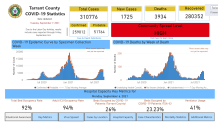Tarrant County’s COVID-19 vaccine demand is slowly increasing but there’s also an increase in new cases, hospitalizations, and deaths, according to the county public health director.
The county reported 1,725 new cases on Tuesday.
According to the latest county data, 26% of the hospital beds in Tarrant County are occupied by COVID-19 patients. The total bed occupancy rate is 92%.

Get DFW local news, weather forecasts and entertainment stories to your inbox. Sign up for NBC DFW newsletters.
“Really, the concern is for our kids,” Tarrant County Public Health director Vinny Taneja said Tuesday. “We’re seeing a rapid increase in hospitalizations with kids. We’re seeing record numbers of kids getting hospitalized with COVID.”
Children under the age of 12 are currently not eligible to be vaccinated against COVID-19, but Taneja noted vaccination rates for those who are eligible remain low.
“We’re in the 30% mark in the 12 to 15-year-olds. I think we’re in the 40% range in the 15 and older,” Taneja said. “A lot of these kids don’t get to make the decision on their own. It’s the parents who have to understand that the vaccine is available and it will protect their child. So, it is my appeal to parents…get the facts. The vaccine is safe. Let’s get your kids vaccinated. They don’t have any other protection as they go into school.”
Local
The latest news from around North Texas.
At a briefing before county commissioners, Taneja said the COVID-19 positivity rate in Tarrant County remains around 21%. Tarrant County Judge Glen Whitley indicated he would consider revisiting the idea of offering an incentive for people who get vaccinated, which is an idea he first discussed months ago.
“My biggest problem is we’re paying people to procrastinate. I’d rather be able to go back and find a way to pay everyone. I’m not sure we can do it but with the success that Harris County has had, then I think we got to look at doing something,” Judge Whitley said. “We’re going to look at incentivizing our own employees because if we can keep them from getting COVID, that’s a cost to our benefit plan but it’s also a situation where we’re going to look at incentivizing everybody in the county in the effort of trying to flatten this out.”
First responders in North Texas are seeing the impact of the spike in COVID-19 cases firsthand. Matt Zavadsky with MedStar said in June, crews saw an average of about 50 patients with the potential for COVID-19 each day.
“Now, we’re at 131 patients a day,” Zavadsky said. “That sort of mirrors what we’re seeing the rest of the community with regard to community spread, hospitalizations. So, it is very concerning.”
Zavadsky pointed to two main contributing factors, including the delta variant.
“Second, people are really suffering from pandemic fatigue. Not only the healthcare workers like MedStar and the frontline healthcare workers but also the community in general,” he said. “So, there’s a lot of people who aren’t necessarily wearing masks. They’re not doing those things that we were doing back in the beginning of the summer to help flatten the curve. So, those things combined have really led to this dramatic surge.”
To help with hospital capacity, one of MedStar’s protocols has been to not transport patients with symptoms consistent with COVID-19 if they are in stable condition.
“We give them information, we give them printed materials on how to get tested, how to seek other care because we’re really trying to help preserve the capacity in our local emergency departments by doing that,” he said. “The next patient who we respond to who is having chest pain or difficulty breathing or had their hand cut off, those are the patients that we’re going to take to the emergency room.”
In May and June, Zavadsky said they turned to that protocol once every three days or so. However, they have recently had to use protocol about eight times a day.
“All of the frontline healthcare workers including first responders are right now, stretched to the max. In addition to the patient volume, we’ve got our own employees’ healthcare workers who are out from work because they have COVID and have to be quarantined,” he said. “So, we really ask the community to do the things that you can do to help prevent becoming a patient and expend some of the resources that we’re really trying to save for the high priority patients.”



